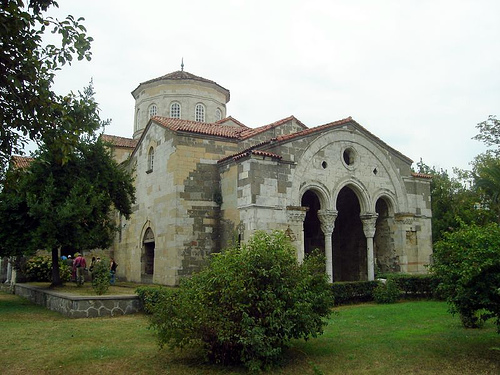|
Guide :
|
|
|
|
User Name:
Password:
|
|
|
|
|
|
|
ST.SOPHIA
MUSEUM

The Ayasofya (Hagia Sophia) church, now used a museum,
was built during the reign of Manuel Comnenos I, one of the kings of the Empire
of Trabzon (1238-1263). Following Trabzon 's conquest by Sultan Mehmet, the Conqueror
in 1461, the church was transformed into a mosque. For centuries, the Hagia Sophia
church has attracted the attention of travellers and researchers visiting the city.
Of these, Evliya Chelebi (1648), Pitton de Tournefort (1701), Hamilton (1836) Taxier
(1864), Sakir Sevket of Trabzon (1878), and Lynch (1893) are well-known. It is known
that the mosque, which had been in a state of ruin, was restored in 1864 as a result
of insistent attempts by Riza Efendi of Bursa . It was used as a depot and hospital
respectively during the First World War but was redesigned as a mosque again after
the war. It was reopened as a museum in 1964 after the joint restoration project
carried out by the Directorate of Foundations and Edinburgh University between 1958
and 1962. The building is a very good example of late Byzantine architecture. It
has a cruciform plan with a high central dome. It has a vestibule called a narthex,
and three aisles. The central aisle has a pentagonal abscissa and the adjacent aisles
end with semi-circular abscissas. The building has three porches on the north, west
and south sides. The dome has twelve corners and is supported by four marble monolithic
columns, arches and pendants. There are vaults around the central dome and the roof
has different heights and is covered with tiles. In addition to the elements reflecting
the traditions of Christian art, the influence of Islamic Seljuk art can also be
seen in the stone reliefs. The panels on the north and west porches are decorated
with interlocking geometric designs and the ornate niches on the west side have
the characteristics of Seljuk-period stone carving. The most impressive side of
the building is the south side. Here, on a frieze, the creation of Adam and Eve
is depicted in relief. The 1st scene depicts the creation of Adam and Eve. The 2nd
scene depicts the lives of Adam and Eve in the gardens of Eden . The 3rd scene depicts
Adam and Eve pick the Forbidden Apple in the Eden . The 4th scene depicts their
dismissal from the Garden, and the 5th scene depicts the first murder. On the keystone
of the arch is a single-headed eagle motif that is the symbol of the Comnenos dynasty
that ruled Trabzon for
257 years. A similar eagle design is found on the exterior
of the main east abscissa. On this façade are the figures of mythical creatures
such as griffons and centaurs, reliefs depicting doves, and panels decorated with
stars and crescent designs in the centre, and medallions with floral designs. The
floor below the main dome is covered with mosaic in opus-sectile technique made
marbles of different colours. The frescoes, most of which depicting scenes from
the Bible, are an important part of the decoration of the church. The main scene
on the dome is Jesus Christ, the pantacractor which reflects his divine side. Below
this is a line of inscriptions and below this line of inscriptions is a frieze of
angels. The 12 apostles are depicted on the pendentives. Various other scenes such
as the birth of Christ, his baptism, his crucifixion and resurrection are also depicted
here. On the outside of the eastern wall are some carvings showing boats and sailboats
of various sizes which are considered to be dating from 1450 to 1850. We don't know
for sure by whom and for what reason they were made. It is believed that they were
carved by the people of the region who were sailors and who sailed a lot to get
protection from the God.
The Tower : The tower of Hagia Sophia
Church was built in 1427. As time passed, the first floor of the tower that was
used as a chapel was ruined, the vaulted roof collapsed and the paintings on it
destroyed. However, the paintings on the chapel walls have been preserved up to
the present day. Arch windows fill the centres of the north and south walls. Beginning
in 1443, the depictions on the abscissa wall were completed in a very short time.
|